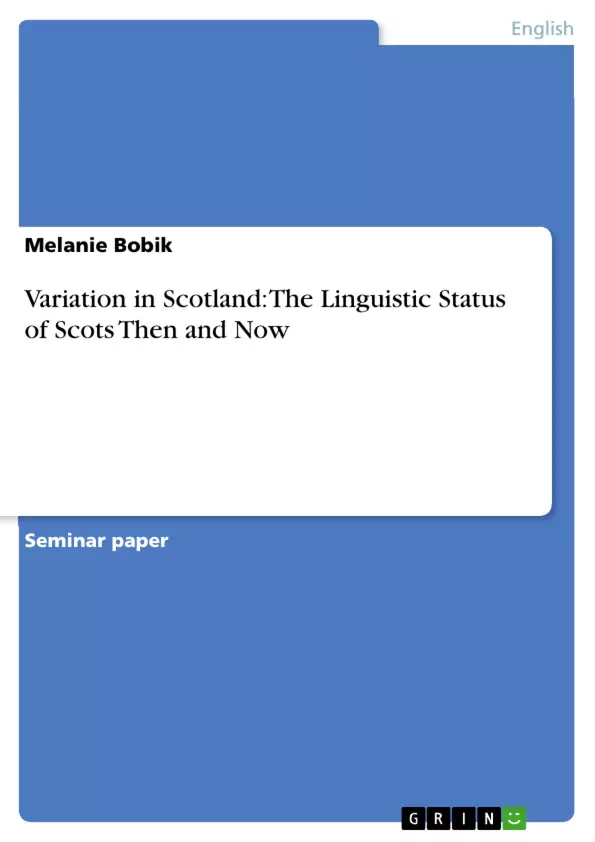The linguistic status of Scots today is certainly best described as ambiguous. Scots is unique because it has a clearly defined history of its own and it has always possessed enough distinctive features to be very different from Standard English.
Of all the varieties of English which have developed within the British Isles, there is none that created such controversy and still challenges even the best scholars.
This paper tries to find out about the possibility of labelling Scots a language or a dialect. In addition to that, it takes a closer look at the linguistic features of Middle Scots and the situation of Scots today.
Includes comprehensive sources for further reading and research.
Inhaltsverzeichnis (Table of Contents)
- Introduction
- The Status of Scots Speech
- Language or Dialect - A General Distinction
- Standardisation
- Rise and Fall of Middle Scots
- Linguistic Characteristics of Middle Scots
- Orthography and Phonology
- The Vowels
- The Consonants
- Morphology
- Lexis
- Latin Influence
- French Influence
- Gaelic Influence
- Dutch Influence
- Old Norse Influence
- Orthography and Phonology
- The Situation Today
Zielsetzung und Themenschwerpunkte (Objectives and Key Themes)
This paper aims to explore the debate surrounding the linguistic status of Scots, specifically examining whether it should be categorized as a language or a dialect. It further investigates the linguistic characteristics of Middle Scots and its current situation. Key themes explored in this paper include:- The definition and distinction between language and dialect
- The role of standardisation in language development
- The historical evolution of Scots, particularly its rise and fall as a national language
- The linguistic features of Middle Scots, including its orthography, phonology, morphology, and lexis
- The current status of Scots in the context of its historical background
Zusammenfassung der Kapitel (Chapter Summaries)
The introduction presents the ambiguity surrounding the linguistic status of Scots, highlighting the ongoing conflict between supporters and opponents of its official recognition. The paper aims to clarify the potential categorization of Scots as a language or dialect, as well as analyze the linguistic characteristics of Middle Scots and its current situation.
Chapter 2 delves into the concepts of language and dialect, exploring their definitions and how they are influenced by the presence or absence of a standard variety. The chapter also discusses the role of standardisation in establishing a language, highlighting its political, social, and economic implications. Finally, it examines the rise and fall of Middle Scots as a national language during the 15th and 16th centuries, analyzing the factors that contributed to its development and eventual decline.
Chapter 3 focuses on the distinctive linguistic features of Middle Scots. It begins by discussing the orthography and phonology of Middle Scots, exploring its vowel and consonant systems, including the use of graphemes and digraphs. The chapter then delves into the morphological and lexical characteristics of Middle Scots, highlighting influences from Latin, French, Gaelic, Dutch, and Old Norse.
Schlüsselwörter (Keywords)
This paper centers around the linguistic analysis of Scots, exploring its status as a language or dialect, examining the features of Middle Scots, and discussing the historical and contemporary context of its development. Key terms include: language, dialect, standardisation, Middle Scots, orthography, phonology, morphology, lexis, Latin, French, Gaelic, Dutch, Old Norse, and the present-day status of Scots.- Quote paper
- Magister Artium Melanie Bobik (Author), 2001, Variation in Scotland: The Linguistic Status of Scots Then and Now, Munich, GRIN Verlag, https://www.grin.com/document/149221



